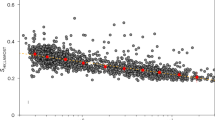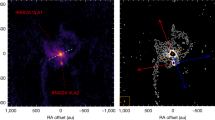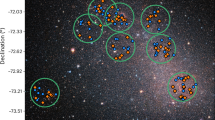Abstract
ONE of the questions which the modern theory of stellar evolution fails to explain is why there are no stars rotating with extreme equatorial velocities. It is easy to see that the rotation of protostars is restricted because of the conservation of angular momentum during contraction, but if the type of rotation remains unchanged, angular velocity should be connected with the radius of a protostar by the relationship  where the subscript refers to initial values. The limiting angular velocity ωlim is given by
where the subscript refers to initial values. The limiting angular velocity ωlim is given by  Taking
Taking  we obtain ω≈ωlim if R ∼ 0.4R0, that is, the rotation of the protostar is restricted before the star itself is formed. Thus the angular momentum of a protostar exceeds that of main sequence stars by 104. Removing this difficulty by taking magnetic fields into consideration, we are faced with another problem : why magnetic stars rotate rapidly when they ought to have lost their angular momentum. Neither is it easy to explain why the rotational velocities of stars of early spectral type increase with the radius of a star. Problems in the origin of close binary systems are also well known. We would like to point out a further difficulty in the polar character of the stellar magnetic field.
we obtain ω≈ωlim if R ∼ 0.4R0, that is, the rotation of the protostar is restricted before the star itself is formed. Thus the angular momentum of a protostar exceeds that of main sequence stars by 104. Removing this difficulty by taking magnetic fields into consideration, we are faced with another problem : why magnetic stars rotate rapidly when they ought to have lost their angular momentum. Neither is it easy to explain why the rotational velocities of stars of early spectral type increase with the radius of a star. Problems in the origin of close binary systems are also well known. We would like to point out a further difficulty in the polar character of the stellar magnetic field.
This is a preview of subscription content, access via your institution
Access options
Subscribe to this journal
Receive 51 print issues and online access
$199.00 per year
only $3.90 per issue
Buy this article
- Purchase on SpringerLink
- Instant access to full article PDF
Prices may be subject to local taxes which are calculated during checkout
Similar content being viewed by others
References
Lichtenstein, L., Math. Zeitschr., 13, 82 (1922).
Ostriker, J., Astrophys. J., 140, 1067 (1964).
Isserstedt, I., and Schmidt-Kaler, T., Veröff, Astro. Inst. Ruhr Univ. Bochum, No. 1 (1968).
Porfiriev, V. V., A. J. USSR, 39, 710 (1962).
Author information
Authors and Affiliations
Rights and permissions
About this article
Cite this article
PORFIRIEV, V., SHULMAN, L. & ZHILYAEV, B. Toroidal Stages in Stellar Evolution. Nature 222, 255–256 (1969). https://doi.org/10.1038/222255a0
Received:
Issue date:
DOI: https://doi.org/10.1038/222255a0



